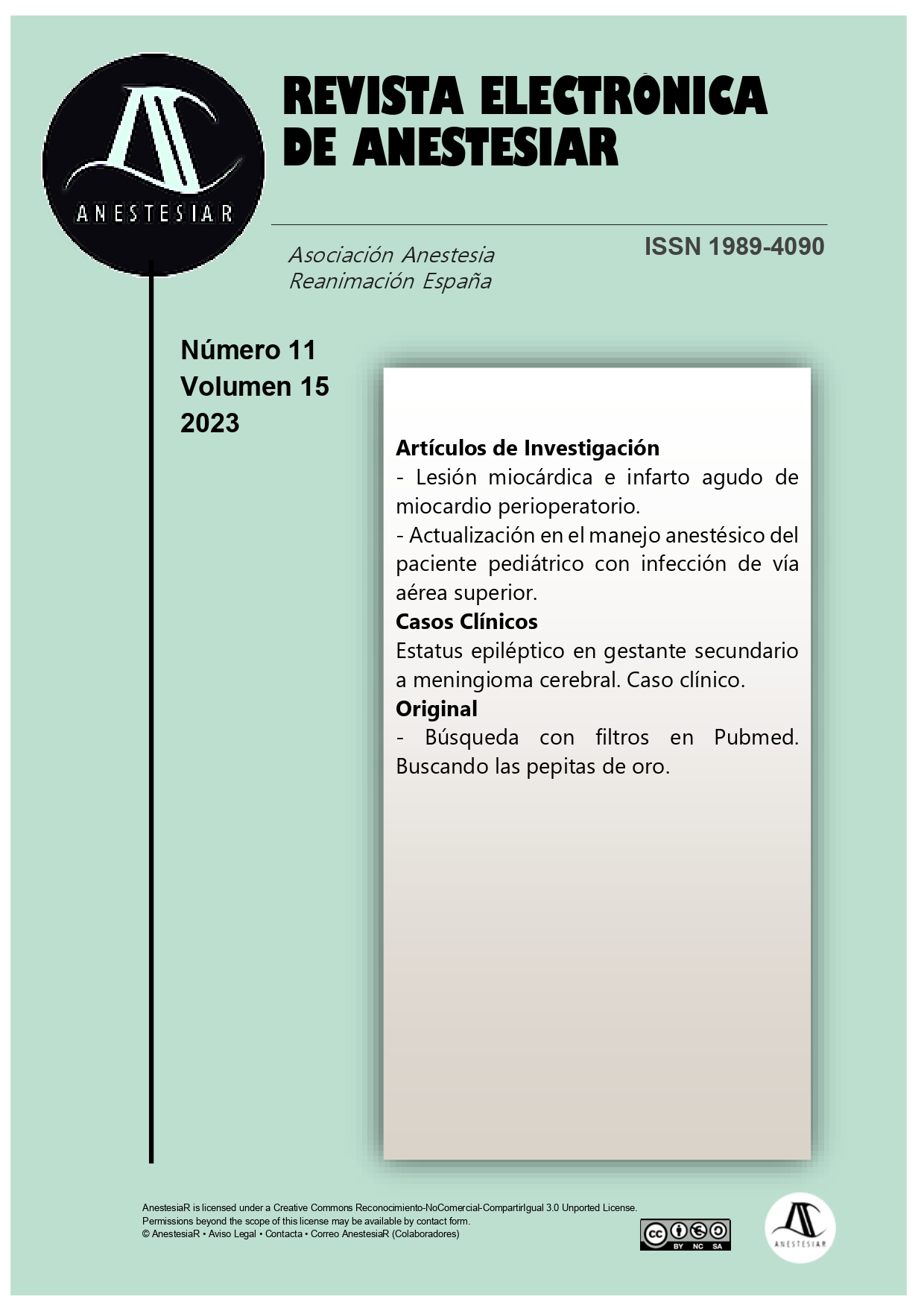Update on the anesthetic management of the pediatric patient with upper airway infection.
DOI:
https://doi.org/10.30445/rear.v15i11.1158Keywords:
Pediatric patient, URTI, PRAE, Airway hyperreactivityAbstract
The high incidence of upper respiratory tract infections (URTI) in childhood means that a significant percentage of pediatric patients presenting for elective surgery present symptoms of IVAs at that time or in the previous weeks. Receiving general anesthesia under this condition implies an increased risk for the appearance of perioperative respiratory adverse events (PRAE), which also lasts up to six weeks after having suffered a URTI due to the persistence of hyperreactivity in the airway. Despite the fact that most of the complications are mild and easy to manage, sometimes serious clinical entities can arise that increase morbidity and mortality and generate an increase in health care costs due to prolonged hospital stays and the need to apply additional resources.
The purpose of this review is to present an updated summary of the current evidence about the risk factors and mechanisms that lead to the appearance of PRAE in pediatric patients presenting with URTI at the time of elective surgery, as well as the different strategies for its anesthetic management in the different phases of the anesthetic-surgical process. This is key to selecting those cases in which delaying surgical intervention will be of clear benefit, fundamentally for the patient, but also for the better functioning of the health system.
References
- Tait AR, Malviya S. Anesthesia for the child with an upper respiratory tract infection: still a dilemma?. Anesth Analg. 2005;100(1):59-65. doi:10.1213/01.ANE.0000139653.53618.91
- Bramley TJ, Lerner D, Sames M. Productivity losses related to the common cold. J Occup Environ Med. 2002 Sep;44(9):822–9. https://doi.org/10.1097/00043764-200209000-00004 PMID:12227674
- Monto AS, Ullman BM. Acute respiratory illness in an American community. The Tecumseh study. JAMA. 1974 Jan;227(2):164– 9. https://doi.org/10.1001/jama.1974.03230150016004 PMID:4357298
- von Ungern-Sternberg BS, Boda K, Chambers NA, et al. Risk assessment for respiratory complications in paediatric anaesthesia: a prospective cohort study. Lancet. 2010;376(9743):773-783. doi:10.1016/S0140-6736(10)61193-2
- Rosete ODP, Archundia SFJ, Cabello GC, et al. Patogenia de las infecciones respiratorias por virus. Rev Inst Nal Enf Resp Mex. 2002;15(4):239-254.
- Mamie C, Habre W, Delhumeau C, Argiroffo CB, Morabia A. Incidence and risk factors of perioperative respiratory adverse events in children undergoing elective surgery. Pediatr Anesth. 2004;14:218-224.
- Lee B.J., August D.A. COLDS: A heuristic preanesthetic risk score for children with upper respiratory tract infection. Paediatr. Anaesth. 2014;24:349–350. doi: 10.1111/pan.12337
- Lee L.K., Bernardo M.K.L., Grogan T.R., Elashoff D.A., Ren W.H.P. Perioperative respiratory adverse event risk assessment in children with upper respiratory tract infection: Validation of the COLDS score. Paediatr. Anaesth. 2018;28:1007–1014. doi: 10.1111/pan.13491.
- Regli A., Becke K., von Ungern-Sternberg B.S. An update on the perioperative management of children with upper respiratory tract infections. Curr. Opin. Anaesthesiol. 2017;30:362–367. doi: 10.1097/ACO.0000000000000460.
- Shemesh S, Tamir S, Goldfarb A, Ezri T, Roth Y. To proceed or not to proceed: ENT surgery in paediatric patients with acute upper respiratory tract infection. J Laryngol Otol. 2016;130(9):800-804. doi:10.1017/S0022215116008549
- Rosenbaum A, Kain ZN, Larsson P, Lönnqvist PA, Wolf AR. The place of premedication in pediatric practice. Paediatr Anaesth. 2009;19(9):817-828. doi:10.1111/j.1460-9592.2009.03114.x
- Yip P, Middleton P, Cyna AM, Carlyle AV. Non-pharmacological interventions for assisting the induction of anaesthesia in children. Cochrane Database Syst Rev. 2009;(3):CD006447. Published 2009 Jul 8. doi:10.1002/14651858.CD006447.pub2
- von Ungern-Sternberg BS, Habre W, Erb TO, Heaney M. Salbutamol premedication in children with a recent respiratory tract infection. Paediatr Anaesth. 2009;19(11):1064-1069. doi:10.1111/j.1460-9592.2009.03130.x
- Tait AR, Burke C, Voepel-Lewis T, Chiravuri D, Wagner D, Malviya S. Glycopyrrolate does not reduce the incidence of perioperative adverse events in children with upper respiratory tract infections. Anesth Analg. 2007;104(2):265-270. doi:10.1213/01.ane.0000243333.96141.40
- Deckx L, De Sutter AI, Guo L, Mir NA, van Driel ML. Nasal decongestants in monotherapy for the common cold. Cochrane Database Syst Rev. 2016;10(10):CD009612. Published 2016 Oct 17. doi:10.1002/14651858.CD009612.pub2
- Hayward G, Thompson MJ, Perera R, Del Mar CB, Glasziou PP, Heneghan CJ. Corticosteroids for the common cold. Cochrane Database Syst Rev. 2015;2015(10):CD008116. Published 2015 Oct 13. doi:10.1002/14651858.CD008116.pub3
- von Ungern-Sternberg BS, Davies K, Hegarty M, Erb TO, Habre W. The effect of deep vs. awake extubation on respiratory complications in high-risk children undergoing adenotonsillectomy: a randomised controlled trial. Eur J Anaesthesiol. 2013;30(9):529-536. doi:10.1097/EJA.0b013e32835df608
- Baijal RG, Bidani SA, Minard CG, Watcha MF. Perioperative respiratory complications following awake and deep extubation in children undergoing adenotonsillectomy. Paediatr Anaesth. 2015;25(4):392-399. doi:10.1111/pan.12561
- Schebesta K, Güloglu E, Chiari A, Mayer N, Kimberger O. Topical lidocaine reduces the risk of perioperative airway complications in children with upper respiratory tract infections. Can J Anaesth. 2010;57(8):745-750. doi:10.1007/s12630-010-9328-y
- Hamilton ND, Hegarty M, Calder A, Erb TO, von Ungern-Sternberg BS. Does topical lidocaine before tracheal intubation attenuate airway responses in children? An observational audit. Paediatr Anaesth. 2012;22(4):345-350. doi:10.1111/j.1460-9592.2011.03772.x
- Kim SY, Kim JM, Lee JH, Kang YR, Jeong SH, Koo BN. Perioperative respiratory adverse events in children with active upper respiratory tract infection who received general anesthesia through an orotracheal tube and inhalation agents. Korean J Anesthesiol. 2013;65(2):136-141. doi:10.4097/kjae.2013.65.2.136
- Quick M. Cochrane Commentary: Probiotics For Prevention of Acute Upper Respiratory Infection. Explore (NY). 2015;11(5):418-420. doi:10.1016/j.explore.2015.07.012
Downloads
Published
How to Cite
Issue
Section
License
Copyright (c) 2023 Revista Electrónica AnestesiaR

This work is licensed under a Creative Commons Attribution-ShareAlike 4.0 International License.
 Envío y derechos de autor
Envío y derechos de autor


 Revista Electrónica AnestesiaR by
Revista Electrónica AnestesiaR by 